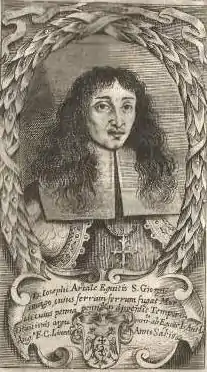Giuseppe Artale
Giuseppe Artale (Catania, 29 August 1628 – Naples, 11 February 1679) was a Sicilian poet, novelist, and duelist, known for his Marinist works. He was also a knight of the Constantinian Order of Saint George.[1]
Giuseppe Artale | |
|---|---|
 Giuseppe Artale | |
| Born | 29 August 1628 |
| Died | 11 February 1679 (aged 50) |
| Resting place | San Diego all'Ospedaletto, Naples |
| Occupations |
|
| Parent(s) | Antonino Artale Angela Artale |
| Honours | Constantinian Order of Saint George |
| Writing career | |
| Language | Italian, Latin |
| Literary movement |
|
| Notable works | Enciclopedia Poetica Cordimarte |
Biography
Giuseppe Artale was born at Catania, in 1628.[2][1] He was descended from an ancient Aragonese family.[1] At fifteen, he made a hurried departure from his native city, where he had killed a rival in a duel.[3] He entered the army soon after, and rendered himself conspicuous by his bravery. For a time, he served as Captain of the Guard to the palatine Ernest of Brunswick-Lüneburg, and was highly esteemed by the emperor Leopold. He distinguished himself in the Cretan War against the Ottoman Empire, and was made a knight of the Constantinian Order of Saint George, with permission to add the imperial eagle, or Double-headed eagle, to his family arms.[4] As a swordsman he was unrivalled, and was commonly known by the appellation of the sanguinary knight, conferred upon him for his success as a well-practised duelist. He died at Naples in 1679, worn out by excess.
Artale was a member of the principal academies of Italy, and enjoyed a considerable reputation as a poet. He is best known today for his heroic romance Cordimarte (1660), and his Enciclopedia poetica (1658-1664), recognised as the last flowering of the pessimistic vein of Neapolitan Marinism.[5] The Enciclopedia poetica, one of the most remarkable Italian poetry collections of the Baroque period, pushes conceptismo to its most extreme forms.[3] The Cordimarte, written in an elaborate rhetorical style, is one of the last and most conspicuous examples of Italian Baroque chivalric romance.[3]
Works
- Dell’Enciclopedia Poetica parte prima, Perugia, 1658; Venice, 1660 and 1664.
- Dell’Enciclopedia parte seconda; ovvero la Guerra fra i vivi e morti, Tragedia di lieta fine; e Il Cor di Marte, historia favoleggiata, Venice, 1660; the fifth edition was published at Naples, 1679.
- Dell'Enciclopedia parte terza ; ovvero l'Alloro fruttuoso. Naples: Antonio Bulifon. 1679.
- La Pasife, ovvero L'Impossibile fatto Possibile, Dramma per Musica. Venice: Giacomo Batti. 1661.
- La Bellezza atterrata: Elegia in occasione del Contagio di Napoli, l'anno 1646. Venice: Giacomo Batti. 1661.
- Anna Maria Razzoli Roio, ed. (1990). Guerra tra vivi e morti. Tragedia di lieto fine. Parma: Università di Parma, Istituto di Filologia Moderna.
- Marzio Pieri, ed. (1990). Il Cordimarte. Parma: Università di Parma, Istituto di Filologia Moderna.
Notes
- Croce 1962.
- Prota-Giurleo 1955, pp. 79–81.
- Slawinski 2002.
- Guy Stair Sainty (2018). The Constantinian Order of Saint George. Boletín Oficial del Estado. p. 95. ISBN 9788434025066.
- Robin Healey (2011). Italian Literature Before 1900 in English Translation: An Annotated Bibliography, 1929-2008. University of Toronto Press. p. 2011. ISBN 9781442642690.
Bibliography
- Slawinski, M. (2002). Artale, Giuseppe. ISBN 978-0-19-818332-7. Retrieved 24 May 2023.
{{cite book}}:|journal=ignored (help) - Jones, John Winter (1843). "Artale, Giuseppe". The Biographical Dictionary of the Society for the Diffusion of Useful Knowledge. Vol. 3. London: Longman, Brown, Green, and Longmans. p. 678.
 This article incorporates text from this source, which is in the public domain.
This article incorporates text from this source, which is in the public domain. - Mazzuchelli, Giammaria (1753). "ARTALE (Giuseppe)". Gli scrittori d'Italia, cioè Notizie storiche e critiche intorno alle vite e agli scritti dei letterati italiani (in Italian). Vol. I, part 2. Brescia: Giambatista Bossini. pp. 1143–1144.
- Croce, Benedetto (1911). Saggi sulla letteratura italiana del '600. Bari. pp. 422, 427, 428, 430.
{{cite book}}: CS1 maint: location missing publisher (link) - Interligi, Gesualdo (1921). Studio su Giuseppe Artale, poeta, drammaturgo, romanziere del secolo XVIII. Catania.
{{cite book}}: CS1 maint: location missing publisher (link) - Croce, Benedetto (1929). Storia dell'età barocca in Italia. Bari. pp. 432–33.
{{cite book}}: CS1 maint: location missing publisher (link) - Prota-Giurleo, Ulisse (1955). "Il cavalier Artale". Il Fuidoro. II (3–4).
- Croce, Franco (1960). "Tre lirici dell'ultimo barocco. I. Giuseppe Artale". La Rassegna della Letteratura Italiana. LXV (3): 393–417.
- Croce, Franco (1962). "ARTALE, Giuseppe". Dizionario Biografico degli Italiani, Volume 4: Arconati–Bacaredda (in Italian). Rome: Istituto dell'Enciclopedia Italiana. ISBN 978-8-81200032-6.
- Battafarano, Italo Michele (1985). ""Epitaffio per se stesso" "Grabschrift / so er ihm macht": Giuseppe Artale und Paul Fleming oder die Poesie als Vanitas und als Transzendenz". Germanisch-Romanische Monatsschrift. 35 (1): 13–26.
- Distaso, Grazia (2006). "Una sperimentazione di lieto fine: la «Guerra tra vivi e morti» di Giuseppe Artale". Studi letteratura italiana per Vitilio Masiello. Bari: Laterza: 785–96.
External links
- Works of Artale at Italian Wikisource